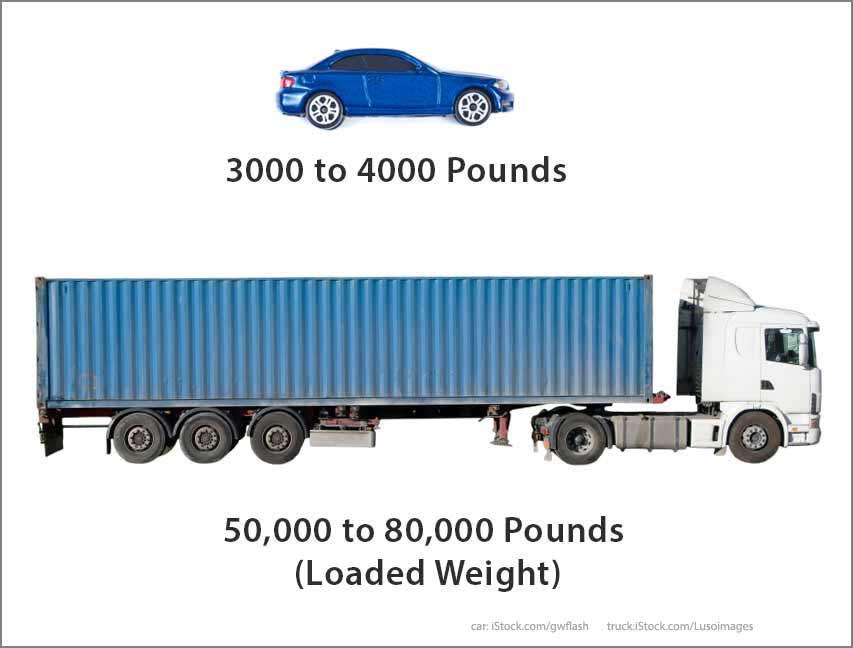Huge semi tractor trailers on the road are a fact of life. We instinctively try to avoid them because they can seem so threatening. About 450,000 accidents between semis and other vehicles occur on U.S. roads every year, killing about 5,000 people. Of those deaths, 75% were in the passenger vehicle. And experts estimate that overall freight tonnage (the weight of cargo hauled by semis) will increase almost 25% from 2013 to 2025. But did you know that there are actual reasons why these big rigs are dangerous to passenger cars and trucks?
1. Semi-Trailers are Heavier Than Cars
Big trucks are so much heavier than passenger cars. In an accident between a semi truck and a passenger car, physics dictates that the car will be more damaged, and the passengers in that car will be more seriously injured. The maximum weight in the United States for a semi truck and full trailer is 80,000 pounds over 18 wheels. The average passenger car weighs about 3500 pounds, and the average pickup truck weights 8,500 pounds. That differential can mean the difference between life and death in a crash. And the weight of these trucks means that they are more difficult to maneuver in tight situations or emergencies. More alarmingly, many states are issuing permits to let semis drive on highways over weight limits.
2. Semi Trucks are Longer
Semi trucks are much longer than passenger trucks or cars. This length adds to the weight of the vehicles. Some trucks actually tow two or more trailers, which increases their length and weight substantially. Some experts call these semis “over the road trains,” and these vehicles have a 11 to 15% higher crash rate than “smaller” semi trucks. And it takes longer for a passenger car to pass a semi than it does another car or pickup truck, which increases the odds that an accident will occur. And that length, again, makes the semi truck more difficult to handle.
3. Semi Accidents More Likely to be Serious or Deadly
Simple physics dictates that a crash between a smaller object and a larger object will damage the smaller object more. Despite advances in passenger car safety, including air bags and crush-resistance frames, the size of semi trucks and the difference with the weight of smaller vehicles means that passenger car occupants are far more at risk for serious injury or death in an accident.

4. Driver Fatigue
As if all that wasn’t enough, there are issues with the semi drivers themselves. These truck drivers are required to limit the number of hours they are on the road, simply because fatigue increases the chances of an accident; this regulation is called “hours of service.” Semi drivers must take a 30-minute rest in their first 8 hours on the road. Bib rig drivers can only work 70 hours a week. Experts say that because there are so many vacancies in the trucking industry, some drivers take on too much work and are pressured to deliver their cargo quickly. And truck drivers aren’t protected by overtime regulations. Driving while sleepy can be just as bad as driving while drunk. Sleepiness decreases awareness time, reaction time, and impairs judgment.
5. Improper Semi Truck Maintenance
All semi trucks on the road are supposed to be well maintained, and the federal government regulates this law. But some companies try to skirt this law, and do not maintain the big rig’s braking systems, engines, signals, lights, and tires. If tires are bald, the vehicle cannot maintain contact with the road, especially if the roads are wet or icy. If the brakes aren’t maintained, it will take longer for the semi to stop. And lack of signals or working lights means that other vehicles will be unaware of the way the semi truck is going to move.
6. Improper Cargo Storage
To help cut down on costs and deliver more freight more quickly, some companies overload trailers and do not balance the freight, which makes the semi truck more unstable and harder to control. Improperly loaded trucks are more likely to jack-knife, and may actually overturn because they aren’t balanced. Improperly balanced loads can shift, leading to the truck actually tipping or rolling over on the road. And this excess weight can put more stress on the brakes and makes the rigs much more difficult to handle, steer, and maneuver. There are strict state and federal weight and size limits put on these vehicles for a reason.
7. Driver Negligence
Sadly, many companies do not properly screen the drivers they hire. Semi truck drivers have been arrested for driving under the influence of drugs or alcohol. Carriers must train their drivers, and the semi trucks must have special education and a license to drive the big rigs. The use of alcohol and/or drugs impairs judgment, makes it more difficult to react in a crisis situation, and can even result in the driver falling asleep behind the wheel. Distracted semi truck drivers are another danger. Using a cell phone while driving is illegal in many states, but drivers of big rigs are just as susceptible to this temptation as the rest of us.
8. Large blind spots
Big rigs have large blind spots, no matter how many mirrors the truck sports. A “blind spot,” also called “no-zone” is an area where the driver cannot see other vehicles around him on the road. These spots exist on the sides of trucks and also in front and at the rear. A semi truck sideswiping a car that was sitting in the blind spot has caused many accidents.
9. Longer stopping distance
Semi trucks take much, much longer to stop on the road than passenger vehicles, especially at freeway speeds. A car or small pickup truck takes about 300 feet to come to a complete stop at 65 miles per hour, while a semi truck takes at least 525 feet to stop, in addition to the 60 feet the vehicle travels during reaction time. Surprisingly, it can take an empty semi truck longer to stop than a fully loaded one, because the empty truck has less traction on the road and the truck can bounce or the brakes can lock.
10. Longer acceleration distance
Finally, big rigs take a much longer time to accelerate than passenger cars or trucks. This can be a factor when the semis are merging onto highways. Many accidents have been caused when a semi merges or pulls out onto a roadway without calculating the acceleration distance needed. Other vehicles on the road can rear end the semi because they don’t have enough time to stop.
People driving passenger cars and light trucks can take advantage of this knowledge to stay safe on the road. Stay away from big rigs if you can. If you need to pass a semi truck, do so quickly. Leave adequate following distance between your car and a semi in front of it. Be aware of blind spots, and move through them quickly. And if you see a semi on the road that appears to be weaving or moving erratically, get away as soon as you can, find a place to safely stop, and alert the authorities.
